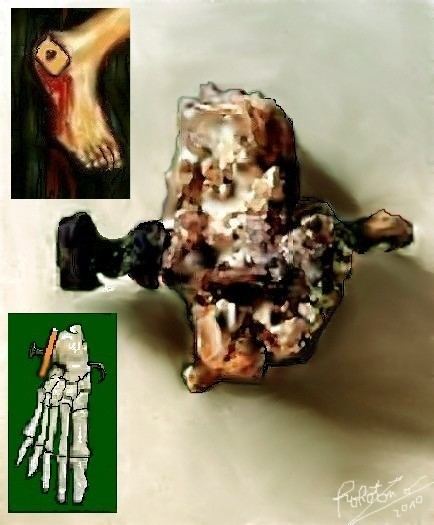Name Jehohanan Jehohanan | ||
 | ||
Bible archeology proof of crucifixion Jehohanan Nail
Jehohanan (Yehohanan) was a man put to death by crucifixion in the 1st century CE, whose ossuary was found in 1968 when building contractors working in Giv'at ha-Mivtar, a Jewish neighborhood in northern East Jerusalem, accidentally uncovered a Jewish tomb. The Jewish stone ossuary had the Hebrew inscription "Jehohanan the son of Hagkol". In his initial anthropological observations in 1970 at Hebrew University, Nicu Haas concluded Jehohanan was crucified with his arms stretched out with his forearms nailed, supporting crucifixion on a two-beamed Latin cross. However, a 1985 reappraisal discovered multiple errors in Haas's observations.
Contents
- Bible archeology proof of crucifixion Jehohanan Nail
- Jehohanan Playlist
- Initial Observations Haas 1970
- Reappraisal Zias Sekeles 1985
- References
Jehohanan Playlist
Initial Observations, Haas, 1970
In his article "Anthropological Observations on the Skeletal Remains from Giv'at ha-Mivtar" published in the Israel Exploration Journal in 1970, Nicu Haas of the Department of Anatomy at Hebrew University, wrote of the remains of a man crucified:
Haas was unable to examine the remains any further because of serious health problems, and while his conclusions became widely accepted by the general public, several errors in his observations were later identified by Joseph Zias and Dr. Eliezer Sekeles at the Hebrew University - Hadassah Medical School in their 1985 reappraisal.
Reappraisal, Zias & Sekeles, 1985
In 1985, Joe Zias, curator of the Israel Department of Antiquities and Museums, and Dr. Eliezer Sekeles, from the Hadassah Medical Center, reexamined the crucifixion remains. They discovered that Haas' analysis was fraught with errors:
Zias and Sekeles also stated the presence of the scratch in one of the forearms "was not convincing" evidence of a nail-wound:
In conclusion, The findings of Zias and Sekeles do not indicate a horizontal patibulum cross-beam was attached to the victim's crucifixion device. Jehohanan may have very well extended his arms upward on a crux simplex (simple upright stake). The evidence was so ambiguous concerning the arms that Zias and Sekeles had to rely on the data provided by Classical writings to support their reconstruction of the position of the arms:
Latest additional quotation from Zias and Sekeles, "The Crucified Man from Giv'at ha-Mitvar: A Reappraisal," Israel Exploration Journal, Vol. 35 (1985), pp. 26;
